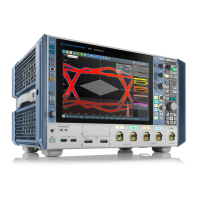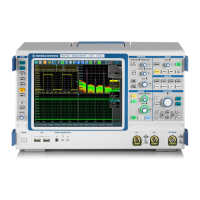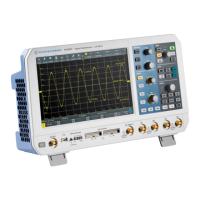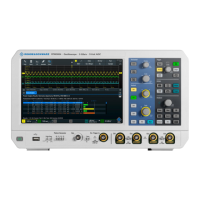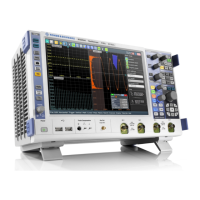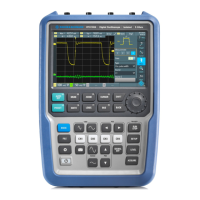Triggers
R&S
®
RTE
241User Manual 1326.1032.02 ─ 20
6.2.4 Setting up an A → B → R trigger sequence
The complete configuration of a complex "A → B → R" trigger sequence consists of:
●
A-trigger condition
●
B-trigger condition in the same way as for the A-trigger, and optional delay time
between the two triggers
●
Optional reset by timeout and/or R-trigger
For details on sequence settings, see Chapter 6.7, "Sequence", on page 270.
1. Press the [TRIGGER] key and select the "Setup" tab.
2. Select the type of the "Sequence": "A → B → R".
3. Tap the "A" subtab and configure the first condition.
See: Chapter 6.2.1, "Configuring a simple trigger", on page 239.
4. Select the "B" subtab and configure the B-trigger condition.
5. Optionally, set the "Delay A -> B" that the instrument waits after an A-trigger until it
recognizes B-triggers.
6. Set the "B event count". The last B-trigger causes the trigger.
7. You can also define a reset condition. The sequence restarts with the A-trigger if no
B-trigger occurs and the reset condition is fulfilled.
a) Select the "R" subtab.
b) To specify a reset by timeout, enable "Reset timeout", and enter the time in
"Timeout".
c) To specify a reset trigger type condition, enable "Reset event" and configure
the reset trigger type.
The trigger types and settings depend on the A and B trigger settings. The
instrument provides only possible, reasonable combinations.
6.3 Trigger types
The setup of the trigger type is the most important part of the trigger definition. It deter-
mines the method to identify specific signal phenomena. Almost all trigger types are
available for all conditions in a trigger sequence, that is, you can combine different
types in the sequence. The instrument checks the trigger settings for compatibility and
feasibility, and disables settings that do not fit the previous settings in the sequence.
The settings in the tab are:
● Basic trigger settings.............................................................................................242
● Edge......................................................................................................................243
● Glitch.....................................................................................................................244
● Width.....................................................................................................................245
● Runt.......................................................................................................................247
● Window................................................................................................................. 248
Trigger types
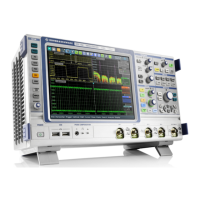
